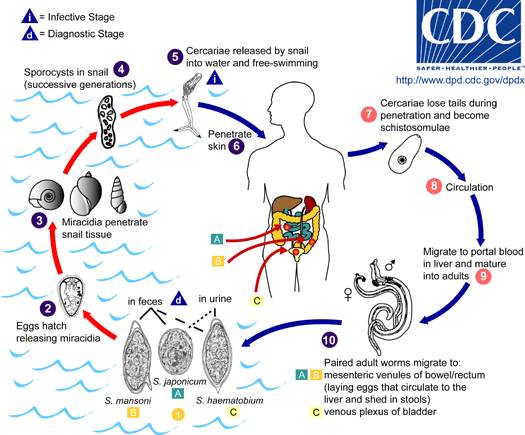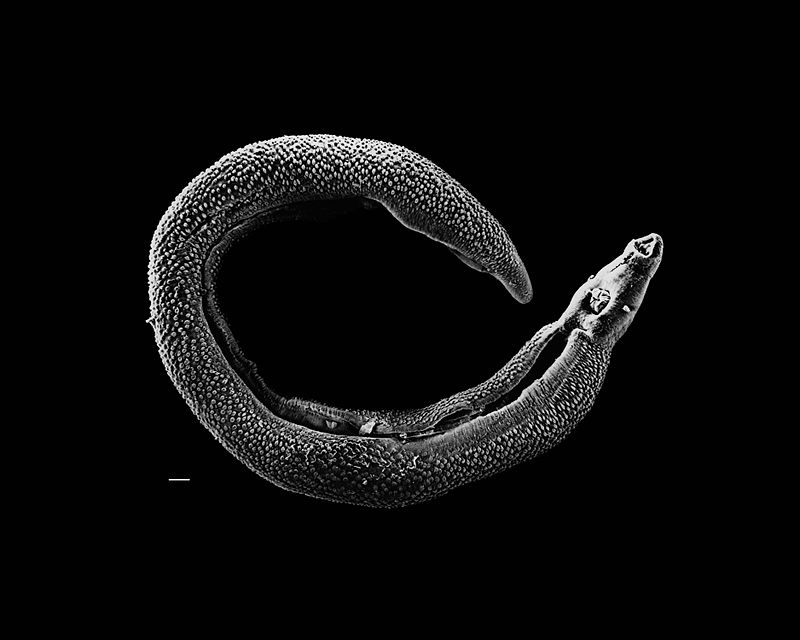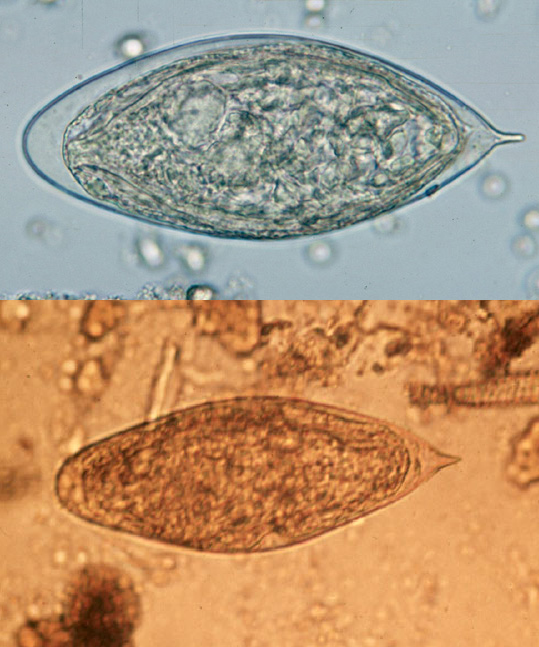Researchers have discovered what they think is the oldest known case of schistosomiasis, dating between 6000 and 6500 years old, having found an egg from the schistosome parasite in sediment collected from the abdomen of skeletal remains on the edge of the Euphrates river in Syria.
Schistosomiasis is a disease caused by trematode flatworms of the genus Schistosoma. Some species infect wild and domestic

animals while others infect humans. The worms have a complex life cycle where eggs are released from the adult worm and hatch on contact with fresh water such as rivers or lakes and free-living miracidia are released. Next the miracidia seek out freshwater snails that act as an intermediate host. They penetrate the snails foot, transform and divide into thousands of cercariae. The cercariae are highly mobile and exit the snail into the water where they swim to find their new human or animal host. The cercariae then penetrate the skin and transform into schistosomulae which enter the blood vessels and migrate to the lung. Inside the lung they transform once again, migrate to the liver and develop an oral sucker to begin feeding on blood. Here, they also form male-female pairs ready for breeding and migrate to blood vessels surrounding the bladder or intestines where they copulate and release eggs into the urine and faeces. People become infected when they wade or swim in infected water contaminated with urine or faeces containing the eggs, if the correct species of snail host is also present.

Schistosoma mansoni (Africa and South America), S. intercalatum (Africa) and S. japonicum and S. mekongi (Asia) cause infections of the veins of the intestine while S. haematobium (Africa) infects the bladder veins. The worms themselves do not cause the illness; instead it is the eggs that have become lodged in the intestine or bladder that cause inflammation or scarring. Symptoms include diarrhoea, blood in the stool and urine, anaemia, malnutrition, enlargement of the spleen and liver and in some cases the development of bladder cancer. It is thought that 240 million people are affected worldwide and 700 million live in endemic areas. Schistosomiasis is second only to malaria in its level of impact as a parasitic disease.
Until recently, the earliest known record of Schistosoma infection was dated to over 5000 years ago when schistosome antigen was detected in the mummified remains of an adolescent from Egypt. However, a recent study in the Lancet has pushed this date back further to approximately 6000-6500 years ago. Dr. Piers

Mitchell and colleagues studied the sediment collected from the abdominal area of 26 individuals from Tell Zeidan, an early (6000-7800bp) agricultural settlement on the banks of the Euphrates in northern Syria. The sediment was sieved using fine mesh micro sieves and then examined using a light microscope. The sediment collected from one individual contained a schistosome egg that was identified as belonging to either the S. haematobium or S. intercalatum species of Schistosoma. Although more recent environmental contamination could not be ruled out, the presence of the egg in a region of the body that would have been naturally infected and the absence of any eggs in sediments collected from control regions, such as the head, suggests that this was a genuine evidence of an ancient infection. The authors also state that as man-made irrigation systems began to spread to the Middle East around 7500bp and that wheat and barley were cultivated at Tell Zeidan, an area which was too arid to support these crops, there was likely to have been an irrigation system present at the site. This would have provided freshwater to allow the intermediate snail host and worm to survive and thus people to become infected. Therefore, the spread of irrigation and increased agricultural productivity in the Middle East is likely to have been accompanied by a spread of the schistosome parasite and the disease it causes. While there have been several reports of schistosome infection in the mummified remains of humans from the Middle East over the last 5000 years, as detected by ELISA and radiology, this is the oldest known evidence of a human infection with Schistosoma.

Comments